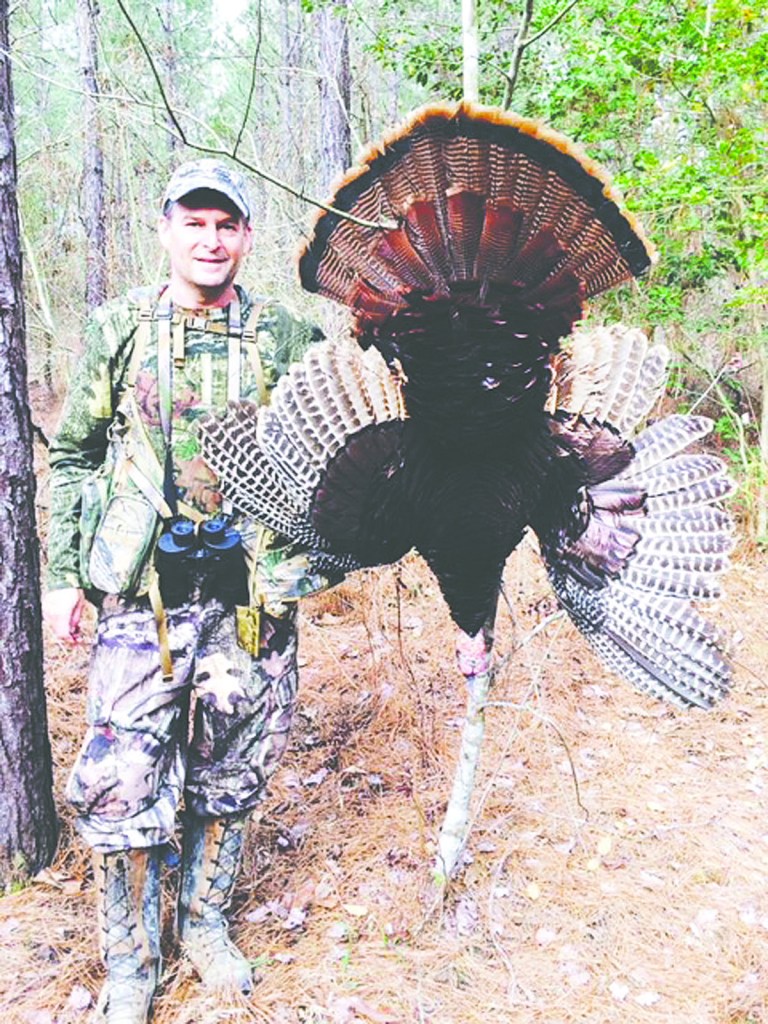Talkin’ turkey
Published 5:45 am Sunday, April 8, 2018

- Troy Romero is at home in the woods hunting turkey in North Louisiana, Mississippi and Texas. The New Iberia outdoorsman shot the turkey, upper left, with his Baretta Xtrema 2 shotgun near Gloster, Miss., in 2013. He killed the turkey in this photo southeast of Jonesboro in North Louisiana in 2015.
A
Trending
fter a quarter-century of turkey hunting with an unbridled passion, Troy Romero still scratches his head over hunts like he had this past week in Mississippi.
The New Iberia outdoorsman heard only one turkey gobble in three days and saw birds, after they saw him, unfortunately, despite hunting in an area full of turkeys. And Romero was the only hunter in those woods.
He also experienced the dreaded lull, a marked reduction in gobbling, that dismays so many hunters of wild turkey.
Male turkeys, Romero and other veteran turkey hunters know, gobble to invite hens to visit for breeding purposes. That gobble also advises turkey hunters of the tom’s position.
But for biological reasons the males stop gobbling, often for one to two weeks, usually a sign that males are content with the females on hand. That means they won’t have to go looking for a gal to hook up with.
So, basically, it’s pointless to scratch or blow a turkey call on the pretense of a being a hen on the lookout for a mate then, which goes against nature, anyway, because males call for females.
Trending
“The gobbling should have been really, really good this week. It just wasn’t. I don’t know why. The weather was perfect,” Romero said Thursday night after unpacking from the trip.
Romero, who lives in rural Iberia Parish between New Iberia and Loreauville with his wife of 19 years, Felicia, and children, Caroline, 18; Amelia Rose, 14; Tucker, 11, and Kate, 9, returned home Thursday with his family turkeyless, although the youngsters had a great fishing trip and caught and released 35 bass up to 5 pounds in a private pond there Tuesday.
“They all love to hunt and fish,” he said.
Romero, 51-year-old vice president of operations (production and distribution) at The McIlhenny Co., has been hunting the oft-elusive, ghostly turkey for nearly half his life in Mississippi, North Louisiana and Texas. He’s at the point where it’s as enjoyable or more enjoyable to call in turkeys for others, he said.
He has killed about 30 turkeys in his career, or, as he estimated, an average of one per 10 hunting trips.
The recent Mississippi trip, which he enjoyed immensely, possibly was his last turkey hunt of 2018. Louisiana’s turkey hunting season opened on Saturday across the state in Area A, where it ends May 6, Area B, where it ends April 29, and Area C, where it ends April 22.
Romero said he was keeping an eye on the weather forecast for the opener. Weather permitting, he would be on his lease in Jackson Parish, southeast of Jonesboro. Rain and turkey hunting don’t mix as the birds really dislike being wet, he said, noting it disrupts their normal routine.
If Romero doesn’t go turkey hunting this weekend, he realizes it might be his only time to hunt due to business and family obligations. Caroline will graduate this spring from Highland Baptist Christian School and Tucker, who also attends HBCS, as do Amelia Rose and Kate, is a “travel ball” baseball player embarking on another season.
Romero, who graduated from Catholic High School in 1984, and from LSU in 1989, grew up duck and goose hunting on family property around Gueydan. He left college and moved to Mississippi for nine years to work in production and distribution for Frito-Lay.
He started deer hunting and turkey hunting while in Mississippi, where he met Alex Stennis, who has been a friend and hunting buddy ever since. Stennis, who now lives in Birmingham, Alabama, is an avid deer hunter.
Romero began turkey hunting in 1992. That quickly became his favorite, although it took him three years to bag his first turkey.
He returned here nearly 19 years ago to work at the McIlhenny Co. His love for turkey hunting, the myriad of challenges it presents each time out, continued to grow.
“I’m passionate about it,” he said. “because of the strategy and challenge it presents. Whether I shoot or not, every time time I do it my heart’s still racing, every time I see a gobbler come in.”
He hunts with a Baretta Xtrema 2 shotgun that he loads with No. 5 Winchester turkey load shells.
When Romero hunts, he won’t consider shooting unless the turkey is 35 to 40 yards away or closer.
“I won’t shoot a turkey farther than 40 yards,” he said, noting some turkey hunters put all types of superchokes on their shotgun and shoot up to 60 yards.
“I’d rather call them in close,” he said.
Caroline Romero, his oldest child, killed her first and only turkey at a distance of 10 yards after he called it in, he said. That memorable outing was three years ago when she was 14.
His turkey calling is top of the line, his friends have said. He learned the intricacies of turkey calling from a turkey hunter in Carthage, Mississippi, who’s now 85 and has killed hundreds of turkeys in Mississippi.
“I’m still practicing. I experiment with new calls,” Romero said.
It is important to know when to call and when not to call, what sounds to make.
“You never stop learning,” he said.
He recalled a turkey hunting trip 15 years ago in Texas with Dr. Monty Rizzo of New Iberia, an ENT specialist who has practiced 44 years.
“Dr. Rizzo and I went to Texas. He said, “You’re not a real good turkey hunter but you’re one of the best turkey callers I ever heard.’ That was 15 years ago. We both limited out. We both killed four turkeys, so I guess I did OK,” Romero said with a chuckle.
His trophies also attest to that. He has mounted a 25-pound Rio Grand turkey with a 13-inch beard that he shot in Texas.
“I think he’s the heaviest I ever killed,” he said.
He also has bagged an Eastern turkey in Mississippi that weighed approximately 23 pounds and had a 9- or 9 ½-inch beard.
He has immersed himself into learning how to mount fans — spread of an adult male’s tail fan feathers.




